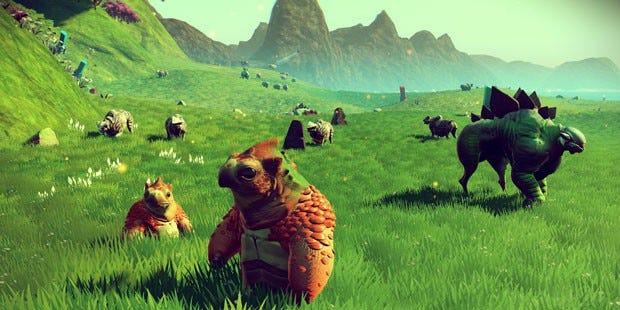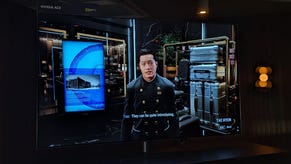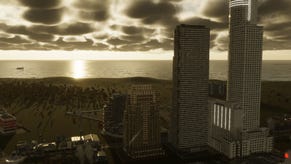No Man's Sky - A Hands On Preview
Across the universe
On a chilly day in February Pip headed out to a little office in Guildford in order to explore a tiny fraction of No Man's Sky [official site], the sandbox exploration survival universe created by Hello Games. Here's what she found:
"You're dying from the cold and you're being chased by two tigers but... 'This is a nice plant'?!"
Hello Games' managing director Sean Murray is watching me as I play a build of No Man's Sky. I have stopped to admire a leaf. In my defence, it's a pretty leaf. In Murray's, there are indeed two tigers and I'm dying from the cold.
The thing is, I got lost while exploring an ice planet. I would probably be a bit less cold but about eight minutes into my play time I also destroyed my spacesuit's thermal shield while experimenting with the menus. Rebuilding that shield so I can survive the kilometer walk back to my ship is one option, building an EMP module which lets me summon my ship directly to a nearby landing pad and then flying somewhere warmer is another. But both will require resources in the form of different elements and the lack of silicon in my vicinity is proving quite the hindrance.
For this demo the game has actually been slightly altered. As Murray puts it, the developers had increased the number of resource crates and things "because we're supposed to sit down with someone like yourself for half an hour and get a feel for a game that needs to be sat and played for five hours." He uses The Long Dark as a reference point. Players will probably die a lot to begin with as they get to grips with the systems and environments.
Unfortunately I don't think anyone (including me) planned on me destroying my thermal shield and thus, even with the tweaked resources I have still managed to become silicon-poor.
I head to a nearby alien building in hopes of finding some resources and fall into conversation with a scientist I find there. I use the term "conversation" loosely. He says something but I only understand a fraction of the words. The rest is written in the Korvax language which shows up as an alien alphabet on screen. As you play you will find ways to learn these languages – there are monoliths which help teach you, for example. Learning means the text now shows up partially in English. The interactions gradually become comprehensible rather than reliant on guesswork.
Murray tells me the correct response for this preview and the scientist gifts me a gun. Hooray! Unfortunately I can't shoot my way out of hypothermia.
In search of blue plants containing the much-needed silicon for my thermal shield I head off across the snow. Pressing down on the D-pad (we're using a Playstation controller for this) scans the area and shows me where I might find resources as well as highlighting other things, like my ship. My distant, distant ship. I could also use the binoculars option to tag waypoints or set markers which then show up on a compass at the top of the screen. There's no minimap so setting your own markers and not - just to pick an example out of thin air - circle-strafing a giant crab until you lose your bearings and then picking an exciting tiger to run towards, would be part of basic prep for heading out.
As I jump and run across the planet's surface I occasionally stop to mine some plutonium by shooting my gun and destroying red crystals spiking out of the ground. In doing so I attract the sentinels. They're these self-replicating drones which were put in place to protect the planets. Murray says you'll learn more about the exact situation as you play but the bottom line is that they've gone a bit too far. I started thinking of them as a weaponised version of the National Trust.
When I watch Murray play, he demonstrates how the sentinels work by shooting his way into a locked building and destroying them as they arrive to investigate. The conflict escalates and beefier enemies show up. Eventually Murray's character is dead and a classic sci-fi quote flashes up on the screen. He will respawn at his most recent save point.
I ask whether the sentinels and the alien NPCs affect the idea of discovery in the game. "Star Trek would be a very boring show if they just landed on one undiscovered planet after another," Murray points out. "The key thing with Star Trek is 'where no man has gone before'. It doesn't bother me that much that an alien created by the computer may have visited this place before. I think that's fine and the trade-off there is we want a living, breathing universe."
As I play, I see what look like comets or shooting stars overhead. Murray tells me they're ships. I think these are trade ships but apparently the person who played the game before me got attacked by a pirate. "He followed him down to the planet that he was trying to land on and wiped him out just as he could see the planet revealing itself underneath. That was a really nice moment," says Murray.
I manage to find enough silicon to rebuild my shield but not enough for the EMP device that will let me summon my ship. I can either walk a kilometer back to it or buy the one that's now on the landing pad. It costs orders of magnitude more than is currently in my character's possession so it's back to the wilderness for me.
Prolonged exposure to the cold, as I head towards the ship marker on my compass, begins to drain the charge on my shield. I perform another scan and head towards a blue marker – blue is for tech resources – and find enough silicon to rebuild my shield ("I will say you passed ten million of them on the way over here," adds Murray, helpfully).
Then suddenly a cave! The cave is warm and I am no longer slowly freezing to death. Murray takes advantage of this respite to show me the page on the menu where the game records the creatures, larger plants and trees that you scan. I only have a handful but it would expand as I explored further and eventually it would look more like a log book, recording information about the planets and what they contain.
I manage to get lost in the cave system and we're running out of preview time. I couldn't shoot my way out of hypothermia but I can use a modification installed on my weapon to blast my way out of the cave system by making my own exit.
I finally reach my ship. Just before I hop in a bigger creature attacks and kills one of the nearby tiger things (I don't remember their in-game name). I turn to observe the killer like David Attenborough would do if this was a wildlife documentary. "He's eating its butt!" I observe, also like David Attenborough would do. "That's the law of the jungle," says Murray.
We leave the predator to its meal of butts and head off into space. This is the part where I really feel the difference in No Man's Sky compared to the other games I play. There's no loading screen to jump you between planet surface and orbit and outer space, you just get in the ship and drive off into the sky. The objects you see on the screen are the actual objects you're heading towards instead of being a stand-in or a piece of static sky art. Thinking back over my time with the game I remember it as feeling peculiarly open. I say "peculiarly" because it's a very rare sensation in a game – I don't remember the last time I felt like a game space was stretching away from me in all directions.
I remember in the trailer, and in Sean's demonstration earlier that day, that flight looked graceful, very dramatically sci-fi. That is not how it feels when I am the pilot. I find the controls take a bit of getting used to and spend the first part of the flight trying not to veer back to the ice planet and not be upside down. We're heading towards one of the planet's moons.
It feels quite hard to get a sense of scale moving from planet to moon as they both seem so big. Thinking about it, that might be because of how the game tweaks space. The moon looms large and sits very close to the planet. It takes maybe a couple of minutes in total for me to get there. If I was going further I could make use of a jump drive.
On page two, discussion of exploration, goals, and the cutting room floor.
"The game is about exploration and actually taking hours and hours to fly between planets isn't that much fun," says Murray. "If I had to choose what's technically correct and what plays well from a gameplay point of view I would definitely pick gameplay and I would definitely pick things that encourage you to explore more, but I like that now in the game there can be places that take you an hour to get to or whatever. I really like that and that's your choice to go and do that.
"Some people get a real kick out of that. Elite has completely realistic scales but ultimately because of the way drives work, which is quite unrealistic, effectively everything is close together. Ultimately it wouldn't matter if you pushed everything far apart but what you would lose is the really nice sci-fi backdrop of having a planet on the horizon."
The landing on this moon is not my finest hour, although the game ensures it's not a disaster. I actually end up approaching a tree at high speed but I press the square button and No Man's Sky takes care of the landing. Instead of crashing in a fiery explosion of foliage and metal the ship is intact and standing on the ground, grazing the trunk of the tree I'd initially landed in.
This moon is temperate so I can stop worrying about my thermal shield for a while. Instead I decide to go for a swim. My suit has oxygen so diving isn't a problem, but not all liquids in No Man's Sky are safe for players so you'd need to gain different tech to be able to explore some areas.
Underwater is a cave system populated by fleshy yellow plants so I head inside. The cave network turns out to be a lot bigger than I'd expected and pretty soon I'm lost. This lostness comes up in a later conversation as a part of the game.
"Watching you play and get lost when you've only got a limited time with the game, maybe that's frustrating or whatever but I like seeing that," says Murray. "People do that stupid thing of losing where their ship is or getting turned around and suddenly starting to think about landmarks and thinking twice before they go somewhere. Because we're so used to games just taking care of us. You go down a corridor and somebody will have played this a thousand times before and [the developers will] have laid all this out for me perfectly - I have no problem going down this cave because obviously I'll be able to find my way out. [Whereas here] you would have started thinking 'I will think twice before I go in a cave otherwise I might get lost.'"
"You have far too much faith in my ability to walk past a cave," is my response to that.
Eventually we surface and head back to land to end the preview. Murray has the controller at this point and starts clambering about, looking for a pretty vista to end on.
"Pretty" is actually a key part of how Hello Games keep No Man's Sky a manageable project instead of spiralling out of control.
"The aesthetic's very purposeful - what a plant looks like in No Man's Sky, what a creature looks like... In some ways that makes the pot of variation smaller because you're choosing generally that things be vibrant, you're choosing that you want... Actually a word I always use is 'pretty'. You're using the generation to make things that are pretty to look at and that's really purposeful. It rules out a lot of things that are grotesque and that are more photorealistic."
The game mechanics are also a point where the team needs to keep tight control. They've gone with a core set which are all geared around getting people to move and to explore. You can't build because that encourages you to set down roots, there's no multiplayer (encountering another player would be more akin to Journey, perhaps, and is expected to be an incredibly rare event) because multiplayer encourages people to cluster and stay.
Encouraging players to move is also the reason the game currently doesn't have temporal aspects like seasons or the deaths of suns or different biomes on a planet. "I don't want [players] to be just staying on one planet. I think some people will but I don't want people being like, 'I can't leave this until I've gone to the North Pole!'"
That's not to say ideas and mechanics beyond the core set haven't been discussed. "It kills me a little bit because we had to cut a lot of those ideas. They're not gone but they're kind of in a box," says Murray. If the game is successful the team might be able to look into the box and reassess some of the ideas but for now it's the core set of survival, exploration, trading and combat.
There's also supposed to be this low-level encouragement to head towards the centre of the universe. It's kind of an aim in the game, although not one that that team are pushing hard. Moving towards the centre you'll find a reasonably linear improvement in terms of better tech, better ships, more valuable resources so that rewards heading inwards and I'm guessing most players will start to drift that way even if they're not deliberately racing towards the point.
Murray adds that the idea of heading to a particular point is sometimes a way of explaining what you could do in the game to someone while they can't play it. Once it's out, he says "I would be disappointed if all anyone wants to do is go towards the centre as soon as possible. I would be happy if some people wanted to explore a single planet. I don't want everyone to do that, it would be such a shame, but it would be such a shame if one person didn't feel that way about one planet. And I want some people to just be traders and just try to level up their ship or character or earn the most amount of money. There isn't necessarily an end point there and there isn't a cut scene once you've become this really great trader or whatever but that's the nature of a lot of sandbox and survival games. The reason for playing and the obviousness of why people play isn't necessarily as clean cut as you must rescue your mum from space prison."
Because I know I've been playing a slightly tweaked version of the game in terms of resources and because the two places I have encountered seemed to have a comparable amount of life and activity I ask how representative my experience has been of the game. Is there a base level of "interest" on each planet or will some be emptier?
"The person playing just before you did not have that experience. I must admit," says Murray. "I sat there watching, feeling really pained because it's somebody walking around quite a barren planet, then we were really lucky at the the end that he came across this crazy, weird-looking creature and that made his playthrough. If that hadn't happened he probably would have walked away and written about how No Man's Sky was dead boring. It kills me - it's a really hard game to demo."
My last question is about the more philosophical responses to No Man's Sky. The development team are creating a digital universe, thus coverage and interview questions can end up being about the things we don't have answers for in our actual universe. My question is whether any of those responses or discussions have changed how Murray has thought about the game or whether that side of it is mostly external to the studio.
"Yeah, the game has remained really simple in my mind and what we're trying to do, and everything else seems to be a little bit crazy. I find it really hard - I naturally cringe a little bit when people do ask the more philosophical questions. I always get this thing of, like, 'Do those planets exist when they haven't been discovered?' and stuff like that and you're like... I want to say "Does the third level of Uncharted 4 until it's been streamed in?' It's a bunch of polygons, it's fine guys! [he laughs] But obviously I would think that because I'm knee-deep in it.
What is has been useful for, he says, is getting to know how people talk about games and what they want from them.
"It's been really interesting to watch what people get excited about and I guess my summary would be how amazingly diverse people who play games are, and how they like to be treated and what they're interested in and what they're looking for from a game and why they think they play a game."
No Man's Sky will be released 21 June, 2016. It'll be available for PC on Steam, GOG, Humble etc at £39.99 ($60)















